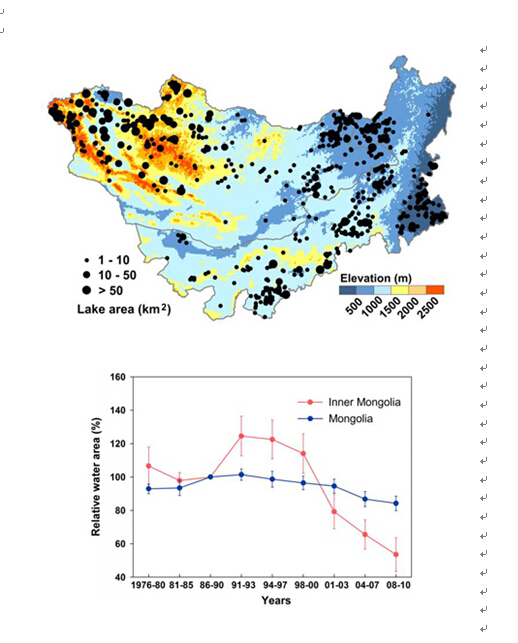Lakes are widely distributed on the Mongolian Plateau and, as critical water sources, have sustained Mongolian pastures for hundreds of years. However, a recent study led by Dr. Jingyun Fang’s group suggests that these lakes have been experiencing remarkable shrinkage over the past three decades due to intensive human activities and climate changes.
In this study, using images of the Landsat satellites from the 1970s to 2000s combined with ground-based censuses, researchers found that the number of lakes with a water surface area of >1 km2 decreased from 785 in the late 1980s to 577 in 2010, with a greater rate of decrease in Inner Mongolia of China (145 lakes, 34.0%) than in Mongolia (63 lakes, 17.6%). Accompanying the decrease in the number of lakes, a rapid shrinkage of lake surface area has also occurred, especially in Inner Mongolia: the total water surface area of the lakes decreased from 4,160.2 km2 in the late 1980s to 2,900.6 km2 in 2010.
The statistical analyses suggested that precipitation was the dominant driver for the lake change in Mongolia, while in Inner Mongolia coal mining was the most important in its grassland area and irrigation was the leading factor in its cultivated area.
The deterioration of lakes is expected to continue in the following decades not only because of changing climate but also increasing exploitation of underground mineral and groundwater resources on the plateau. Thus, scientists suggest that effective action is urgently required to save these valuable lakes. Without it, the lake-loss-induced damages to the natural systems, nomadic culture, and plateau civilization will be disastrous.
This research was recently published online in PNAS, with a title of “Rapid loss of lakes on the Mongolian Plateau” (www.pnas.org/cgi/doi/10.1073/pnas. 1411748112). The study was funded by National Natural Science Foundation of China, National Basic Research Program of China on Global Change, and Strategic Priority Research Program of the Chinese Academy of Sciences.

Fig. (Above) Distribution of lakes with water surface area >1 km2 on the Mongolian Plateau. Inset shows the study area. (Below) Changes in relative water area (RWA, in percent) for medium (10–50 km2) and large lakes (>50 km2) in different periods (from the late 1970s to 2010) in Inner Mongolia and Mongolia, suggesting that RWA peaked in the period 1991–1993 and then declined for both Inner Mongolia and Mongolia, with the former showing greater decrease trend than the latter. The bars show SEs of RWA for each period.
Lakes are widely distributed on the Mongolian Plateau and, as critical water sources, have sustained Mongolian pastures for hundreds of years. However, a recent study led by Dr. Jingyun Fang’s group suggests that these lakes have been experiencing remarkable shrinkage over the past three decades due to intensive human activities and climate changes.
In this study, using images of the Landsat satellites from the 1970s to 2000s combined with ground-based censuses, researchers found that the number of lakes with a water surface area of >1 km2 decreased from 785 in the late 1980s to 577 in 2010, with a greater rate of decrease in Inner Mongolia of China (145 lakes, 34.0%) than in Mongolia (63 lakes, 17.6%). Accompanying the decrease in the number of lakes, a rapid shrinkage of lake surface area has also occurred, especially in Inner Mongolia: the total water surface area of the lakes decreased from 4,160.2 km2 in the late 1980s to 2,900.6 km2 in 2010.
The statistical analyses suggested that precipitation was the dominant driver for the lake change in Mongolia, while in Inner Mongolia coal mining was the most important in its grassland area and irrigation was the leading factor in its cultivated area.
The deterioration of lakes is expected to continue in the following decades not only because of changing climate but also increasing exploitation of underground mineral and groundwater resources on the plateau. Thus, scientists suggest that effective action is urgently required to save these valuable lakes. Without it, the lake-loss-induced damages to the natural systems, nomadic culture, and plateau civilization will be disastrous.
This research was recently published online in PNAS, with a title of “Rapid loss of lakes on the Mongolian Plateau” (www.pnas.org/cgi/doi/10.1073/pnas. 1411748112). The study was funded by National Natural Science Foundation of China, National Basic Research Program of China on Global Change, and Strategic Priority Research Program of the Chinese Academy of Sciences.

Fig. (Above) Distribution of lakes with water surface area >1 km2 on the Mongolian Plateau. Inset shows the study area. (Below) Changes in relative water area (RWA, in percent) for medium (10–50 km2) and large lakes (>50 km2) in different periods (from the late 1970s to 2010) in Inner Mongolia and Mongolia, suggesting that RWA peaked in the period 1991–1993 and then declined for both Inner Mongolia and Mongolia, with the former showing greater decrease trend than the latter. The bars show SEs of RWA for each period.
